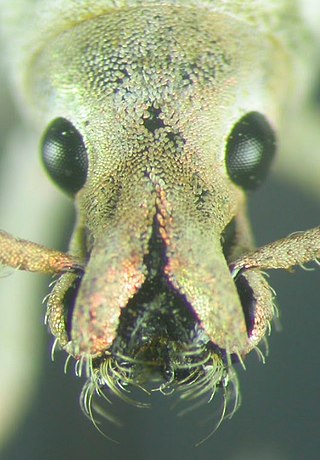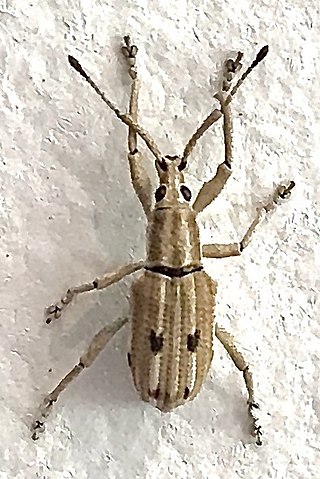
The Entiminae are a large subfamily in the weevil family Curculionidae, containing most of the short-nosed weevils, including such genera as Entimus, Otiorhynchus, Phyllobius, Sitona, and Pachyrrhynchus. In comparison with their stunning diversity, only a few of these weevils are notorious pests of major economic importance. Entimines are commonly encountered in the field, including urban environments, and abundant in entomological collections.

Entimini is a Neotropical weevil tribe in the subfamily Entiminae that includes 46 described species.

Eustylini is a primarily Neotropical weevil tribe in the subfamily Entiminae.

Geonemini is a weevil tribe in the subfamily Entiminae.

Compsus is a genus of broad-nosed weevils in the family Curculionidae, distributed across the Americas, primarily in northern South America.
Epicaerus is a genus of broad-nosed weevils in the family Curculionidae. There are at least 11 described species in Epicaerus.

Pandeleteius is a genus of broad-nosed weevils in the family Curculionidae. There are over 150 described species in Pandeleteius, distributed across the Americas. Most species in the genus were described by Anne Howden.

Artipus is a genus of broad-nosed weevils in the beetle family Curculionidae. There are about 10 described species in Artipus.

Myllocerus undecimpustulatus, known generally as the Sri Lanka weevil or yellow-headed ravenous weevil, is a species of oriental broad-nosed weevil in the beetle family Curculionidae. It damages crops and is resistant to controls. It has spread.

Myllocerus is a genus of oriental broad-nosed weevils in the beetle family Curculionidae. There are at least 330 described species in Myllocerus.

Naupactus cervinus, the Fuller rose beetle or Fuller's rose weevil, is a species of broad-nosed weevil in the family Curculionidae. Native to South America, it has been in North America since the 19th century. This species is believed to reproduce parthogenically as no male specimens have ever been found.

Tropiphorus elevatus is a species of broad-nosed weevil in the beetle family Curculionidae.
Rhigopsis is a genus of broad-nosed weevils in the beetle family Curculionidae. There are at least two described species in Rhigopsis.
Thricolepis is a genus of broad-nosed weevils in the beetle family Curculionidae.
Mitostylus is a genus of broad-nosed weevils in the beetle family Curculionidae. There are about seven described species in Mitostylus.
Peritaxia is a genus of broad-nosed weevils in the beetle family Curculionidae. There are about seven described species in Peritaxia.
Agasphaerops is a genus of broad-nosed weevils in the beetle family Curculionidae. There are at least two described species in Agasphaerops.
Rhypodillus is a genus of broad-nosed weevils in the beetle family Curculionidae. There are at least two described species in Rhypodillus.
Agronus is a genus of broad-nosed weevils in the beetle family Curculionidae. There are at least three described species in Agronus.

Eustylus is a neotropical genus of broad-nosed weevils in the subfamily Entiminae, tribe Eustylini.










